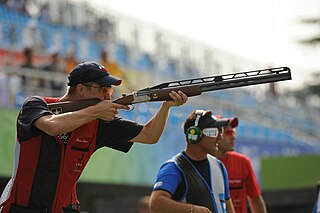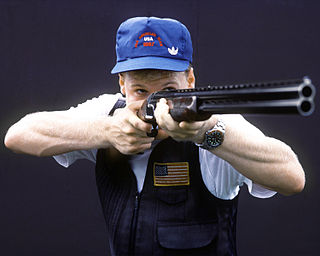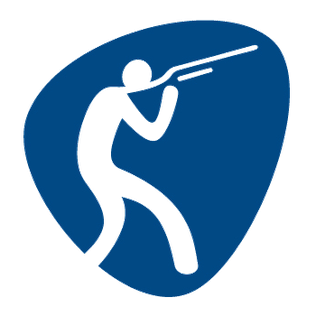
The International Shooting Sport Federation recognizes several shooting events, some of which have Olympic status. They are divided into four disciplines: rifle, pistol, shotgun and running target.

Double trap is a shotgun shooting sport, one of the ISSF shooting events. Participants use a shotgun to attempt to break a clay disk flung away from the shooter at high speed.

Shooting sports have been included at every Summer Olympic Games since the birth of the modern Olympic movement at the 1896 Summer Olympics except at the 1904 and 1928 games.

The 50 meter pistol, formerly and unofficially still often called Free Pistol, is one of the ISSF shooting events. It provides the purest precision shooting among the pistol events, and is one of the oldest shooting disciplines, dating back to the 19th century and only having seen marginal rule changes since 1936. Most of the changes concern distance, caliber, type of pistol, time allowed, and most recently, format of the finals. The target of this event has not changed since 1900, and the 50m distance has remained the standard since 1912. Competitors have been using the small-bore, rim-fire cartridge since 1908. The sport traced back to the beginning of indoor Flobert pistol parlor shooting in Europe during the 1870s, which in turn traced back to 18th-century pistol dueling.

10 meter air rifle is an International Shooting Sports Federation (ISSF) shooting event, shot at a bullseye target over a distance of 10 meters using a 4.5 mm (0.177 in) calibre air rifle with a maximum weight of 5.5 kg (12.13 lb). It is one of the ISSF-governed shooting sports included in the Summer Olympics since the 1984 Los Angeles Games.

The 10 meter air pistol is an Olympic shooting event governed by the International Shooting Sport Federation (ISSF). It is similar to 10 meter air rifle in that it is shot with 4.5 mm caliber air guns at a distance of 10 metres (11 yards), and that the match consists of a qualification round of 60 competition shots within 75 minutes. If an Electronic Scoring System (EST) is not available, 15 minutes are added to the time limit. Competitors are allowed to shoot an unlimited amount of shots during the 15 minutes preparation and sighting time. Along with the 50 meter pistol, it is considered a precision shooting event. Thus, numerous shooters compete in both events.

The International Shooting Sport Federation (ISSF) is the governing body of the Olympic shooting events in rifle, pistol and shotgun disciplines, and of several non-Olympic shooting sport events. ISSF's activities include regulation of the sport, Olympic qualifications and organization of international competitions such as the ISSF World Cup Series, the ISSF World Cup Finals, the ISSF Separate World Championship in Shotgun events and the ISSF World Championship in all events.
The ISSF World Cup was introduced by the International Shooting Sport Federation in 1986 to provide a homogeneous system for qualification to the Olympic shooting competitions. It still is carried out in the Olympic shooting events, with four competitions per year in each event. For the best shooters there is since 1988 a World Cup Final.
The ISSF World Shooting Championships are governed by the International Shooting Sport Federation. World Shooting Championships began in 1897, after the successful 1896 Summer Olympics, and although the ISSF was not founded until 1907, these early competitions are still seen by the organization as the beginning of a continuous row of championships. By this logic, the 2006 competition in Zagreb was called the 49th ISSF World Shooting Championships. These championships, including all ISSF shooting events, are held every four years since 1954. For the shotgun events only, there is an additional World Championship competition in odd-numbered years. These extra competitions are not numbered. In running target, there will be World Championships in Olympic years.
Olympic Skeet is a variant of skeet shooting, and the specific variant used in the Olympic Games. Two throwing machines at different heights launch a series of 25 targets in a specific order, some as singles and some as doubles, with the shooter having a fixed position between them. Both men's and women's competitions consist of five such series. The top six competitors shoot an additional series as a final round, on targets filled with special powder to show hits more clearly to the audience.

Officially referred to only as trap, and also known in the United States as international trap, bunker trap, trench or international clay pigeon, the single-target Olympic trap shooting event has a history of more than a hundred years. It is considered more difficult than most other trap versions in that the distance to the targets and the speed with which they are thrown are both greater.

Paralympic shooting, also known as shooting Para sport, is an adaptation of shooting sports for competitors with disabilities. Shooting is a test of accuracy and control, in which competitors use pistols or rifles to fire a series of shots at a stationary target. Each shot is worth a maximum score of 10.9 points. Athletes use .22 caliber rifles, pistols and .177 caliber air guns. Paralympic shooting first appeared in the Summer Paralympics at the 1976 Toronto Games.

50 meter rifle prone is an International Shooting Sport Federation event consisting of 60 shots from the prone position with a .22 Long Rifle (5.6 mm) caliber rifle. The time limit is 75 minutes for the entire match, including sighting shots, or 90 minutes if there is a need to compensate for slow scoring systems. In the 2013 ISSF rules the 60-shot prone match consists of 15-minute preparation and sighting time, followed by the match – 60 shots in 50 minutes for electronic scoring, and 60 shots in 60 minutes for paper targets.

Shooting competitions at the 2012 Summer Olympics in London took place from 28 July to 6 August at the Royal Artillery Barracks in Woolwich. Fifteen events were included with 390 athletes taking part. The events were the same as in 2008.

Shooting competitions at the 2016 Summer Olympics in Rio de Janeiro took place from 6 to 14 August at the National Shooting Center in Deodoro. A maximum of 390 athletes were able to compete in the fifteen events across these Games. The event format was similar to 2012, although there were significant changes to the rules and guidelines of the competition.
The European Shooting Championships are the global sport shooting European championships as regards the disciplines of the sport shooting of the rifle and the pistol. Sometimes the competition also includes trap shooting, skeet and running target shooting events, usually organized in special championships.

The Philippine National Shooting Association (PNSA) is the National Sports Association (NSA) governing shooting sports in the Philippines, covering both Olympic discipline shooting sports and non-Olympic shooting events like the bench rest or practical pistol. PNSA is the Philippine shooting sport NSA recognized by and a regular member of the Philippine Olympic Committee (POC), funded by the Philippine Sports Commission (PSC).

Shooting competitions at the 2020 Summer Olympics in Tokyo were originally scheduled from 25 July to 3 August 2020, due to the postponement of the Summer Olympics to 2021, the rescheduled dates were on 24 July to 2 August 2021 at the Asaka Shooting Range. Unlike in 2016, the number of shooters competing across fifteen events at these Games had been reduced from 390 to 360, with an equal distribution between men and women. Furthermore, several significant changes were instituted in the Olympic shooting program, including the substitution of three male-only events, with the mixed team competitions.
This article details the qualifying phase for shooting at the 2020 Summer Olympics. 300 quota places for the Games are entitled to the shooters coming from their respective NOCs, based on the results at designated ISSF supervised Championships subjected to the ISSF rules from September 1, 2018, to June 6, 2021. Host nation Japan has been guaranteed twelve quota places with one in each of the individual events. Four quota places will be awarded to the shooters competing in each of the mixed team events, while the highest-ranked shooter, who has not qualified yet or whose NOC does not have a berth in any of the twelve individual events, will obtain a direct Olympic quota place through the World Rankings. The remaining twenty-four quota places are available to the eligible NOCs under the Tripartite Commission Invitation, with two in each of the individual event, to attain a maximum number of 360.












